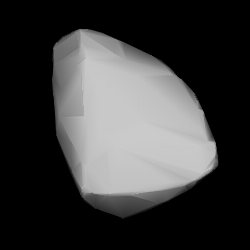
Back 3325 TARDIS Arabic 3325 TARDIS (كويكب) ARZ (3325) TARDIS CE 3325 TARDIS Greek 3325 TARDIS Esperanto (3325) TARDIS Spanish 3325 TARDIS Basque تاردیس ۳۳۲۵ Persian (3325) TARDIS French 3325 TARDIS Hungarian
 Shape model of TARDIS from its lightcurve | |
| Discovery [1] | |
|---|---|
| Discovered by | B. A. Skiff |
| Discovery site | Anderson Mesa Stn. |
| Discovery date | 3 May 1984 |
| Designations | |
| (3325) TARDIS | |
Named after | TARDIS (fictional time machine)[2] |
| 1984 JZ · 1958 VB1 1969 TP3 · 1975 VC8 1975 WF1 | |
| main-belt [1] · (outer) Alauda [3] | |
| Orbital characteristics [1] | |
| Epoch 4 September 2017 (JD 2458000.5) | |
| Uncertainty parameter 0 | |
| Observation arc | 58.56 yr (21,390 days) |
| Aphelion | 3.2299 AU |
| Perihelion | 3.1397 AU |
| 3.1848 AU | |
| Eccentricity | 0.0142 |
| 5.68 yr (2,076 days) | |
| 45.895° | |
| 0° 10m 24.24s / day | |
| Inclination | 22.221° |
| 46.246° | |
| 86.099° | |
| Physical characteristics | |
| 28.238±0.469 km[4] 29.66±1.2 km (IRAS:9)[5] | |
| 0.0553±0.005 (IRAS:9)[5] 0.067±0.010[4] | |
| 11.5[1] | |
3325 TARDIS (provisional designation: 1984 JZ) is a dark Alauda asteroid from the outer region of the asteroid belt, approximately 29 kilometers (18 miles) in diameter. It was discovered on 3 May 1984, by American astronomer Brian Skiff at Lowell's Anderson Mesa Station, Arizona, in the United States.[6] The asteroid was named TARDIS, after the fictional time machine and spacecraft from the science fiction television series Doctor Who.[2]
- ^ a b c d Cite error: The named reference
jpldatawas invoked but never defined (see the help page). - ^ a b Cite error: The named reference
springerwas invoked but never defined (see the help page). - ^ Cite error: The named reference
Ferretwas invoked but never defined (see the help page). - ^ a b Cite error: The named reference
Masiero-2014was invoked but never defined (see the help page). - ^ a b Cite error: The named reference
SIMPSwas invoked but never defined (see the help page). - ^ Cite error: The named reference
MPC-TARDISwas invoked but never defined (see the help page).